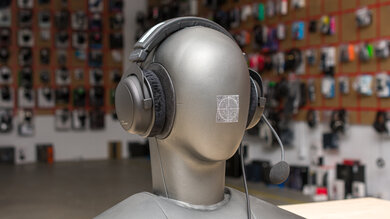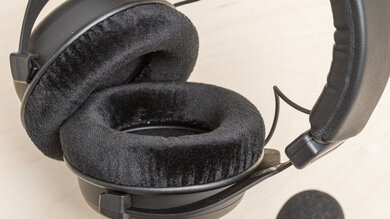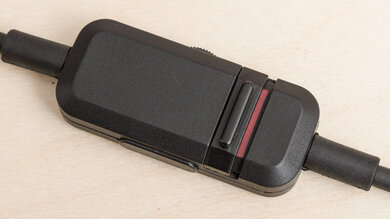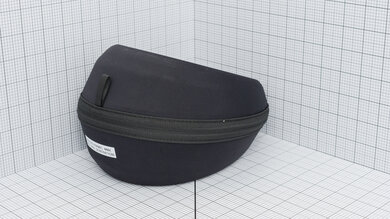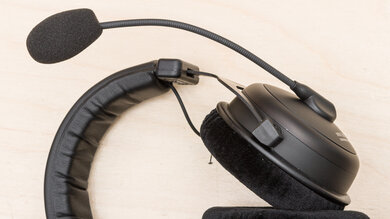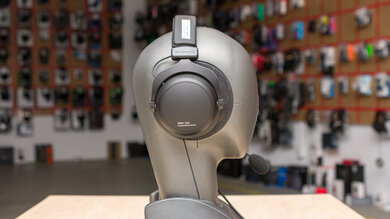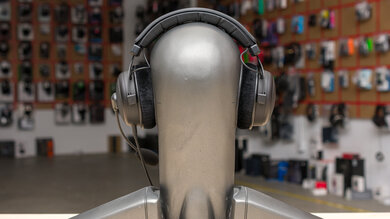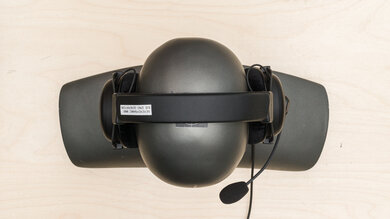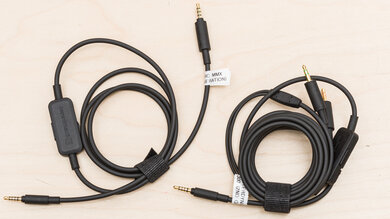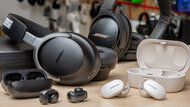Beyerdynamic sensibly refreshes the MMX line with the Beyerdynamic MMX 300 (2nd Generation), gaming headphones aimed at the discerning audio enthusiast. These straightforward headphones boast a mic and in-line controls and come covered in ample padding for long sessions. For the gamer who wants their headphones to take on multiple roles, like listening to music and handling an online meeting while looking professional, these aluminum and light-contrast headphones look the part. Let's see if their simplicity and execution are enough to make them the right pick for you.
Our Verdict
The Beyerdynamic MMX 300 (2nd Generation) aren't designed for sports. Due to their large size and gooseneck mic, these gaming headphones and their bulky size aren't a practical choice for working out. Lots of movement exercises like burpees make them come loose and fall.
-
Comfortable.
-
Unimpressive noise isolation.
-
Not very stable.
-
Not portable.
-
Limited to wired-only connectivity.
The Beyerdynamic MMX 300 2nd Generation are inadequate for traveling because they're meant for gaming. They're large and don't collapse down smaller. While they have a case, it'll take up most of the real estate in your bag. In addition, their passive-only isolation doesn't block environmental noise comprehensively. They feel comfortable to wear and have an in-line remote, but you'll definitely stick out in a crowd with the gooseneck mic.
-
Doesn't need a battery to work.
-
Comfortable.
-
Unimpressive noise isolation.
-
Not very stable.
-
Not portable.
-
Limited to wired-only connectivity.
The Beyerdynamic MMX 300 (2nd Generation) are mediocre for office use. Their velour ear pads and adjustable headband padding feel comfortable, and the mic works well for meetings, but they can clamp down hard on some larger heads. They're also large and bulky and don't effectively block out much environmental noise.
-
Doesn't need a battery to work.
-
Very good mic performance.
-
Comfortable.
-
Unimpressive noise isolation.
-
Not portable.
-
Limited to wired-only connectivity.
You can't use the Beyerdynamic MMX 300 2nd Gen wirelessly.
The Beyerdynamic MMX 300 (2nd Generation) are good for wired gaming. They come with two cables for different connectivity needs, both with in-line remotes. You get ample boom in the bass and clear midrange that helps you hear soundtracks, sound effects, and voices well, although this tuning is bright at the top end. However, you can't EQ them to your tastes because they're passive only, and people who wear glasses or who have smaller heads may experience a drop off in the bass response. On the plus side, the comfortable fit allows you to adjust the headband for long sessions, and the mic captures your speech with very good accuracy and handles noise well enough that your voice remains understandable.
-
Very good mic performance.
-
Great wired connectivity with controls.
-
Comfortable.
-
Unimpressive noise isolation.
-
Limited to wired-only connectivity.
The Beyerdynamic MMX 300 2nd Gen have decent audio reproduction accuracy with a generally balanced sound profile. Their mid-range is flat, so voices and instruments sound true-to-life, but they have a slightly boomy bass and an uncontrolled, bright treble that renders sounds like cymbals piercing. The left and right drivers are generally well-aligned in terms of phase and frequency, though a slightly loose group delay in the bass can make kick drums sound a bit flabby. These are closed-back headphones, so they don't have an open-feeling passive soundstage, but their audio does interact with your outer ear, which can help with sound localization.
The Beyerdynamic MMX 300 (2nd Generation) have poor noise isolation. You'll hear everything from the low rumbles of a bus passing your window to a conversation nearby. They also leak a lot of noise, so people around you will hear your audio.
The Beyerdynamic MMX 300 (2nd Generation)'s mic has a great recording quality that captures your voice accurately and with plenty of body. It also does a good job of separating your voice from any noise around you.
The Beyerdynamic MMX 300 (2nd Generation) have mediocre frequency response consistency, especially in the bass range. They're very sensitive to fit and placement: people with smaller heads or who wear glasses will likely experience reduced bass, while those with larger heads can experience more bass.
- 5.8 Sports And Fitness
- 5.7 Travel
- 6.4 Office Work
- 5.6 Wireless Gaming (In Development)
- 7.6 Wired Gaming (In Development)
Performance Usages
- 7.0 Audio Reproduction Accuracy
- 4.5 Noise Isolation
- 7.7 Microphone (In Development)
- 6.4 Frequency Response Consistency
Changelog
-
Updated Apr 25, 2025:
This review has been updated to Test Bench 2.0, which adds the following tests: Stereo Mismatch, Group Delay, Cumulative Spectral Decay, PRTF, Harmonic Distortion, and Electrical Aspects. We've added new performance usages and updated the text throughout the Sound tests and side-by-sides.
- Updated Apr 25, 2025: We've converted this review to Test Bench 2.0, which updates our sound tests and adds performance usages. You can read more about this in our changelog.
-
Updated Oct 30, 2024:
The following test groups have been updated after Test Bench 1.8: Sound Profile, Raw Frequency Response, Bass Profile: Target Compliance, Mid-Range Profile: Target Compliance, Treble Profile: Target Compliance, and Peaks/Dips. Text changes have also been made throughout the review to match these results.
-
Updated Oct 29, 2024:
Text changes have been made to match results from Test Bench 1.7 to Noise Isolation - Full Range and Noise Isolation - Common Scenarios.
- Updated Oct 28, 2024: We've converted this review to Test Bench 1.8, which updates our target curve and Sound tests. You can read more about this in our changelog.
Check Price
Differences Between Sizes And Variants
The Beyerdynamic MMX 300 (2nd Generation) headset comes in one variant, 'Black.' You can see the label for our unit. If you know of another variant, let us know in the forums.
Compared To Other Headphones
The Beyerdynamic MMX 300 (2nd Generation) represent an update to the first-gen Beyerdynamic MMX 300 by the audiophile manufacturer, and besides an extra cable included with the latest version, they're pretty similar. This line stands out as one of the few entries into gaming headphones geared at critical listeners, alongside the Audeze Maxwell Wireless. They're well-made and straddle the fence between gaming and audio enthusiast headphones, with a permanently attached mic.
For more options, check out the best gaming headsets, and if you don't need a mic, check out our best wired headphones and best audiophile headphones.
The Beyerdynamic MMX 300 (2nd Generation) and Audeze Maxwell Wireless are both manufactured with audio enthusiasts in mind, with great sounding mics and not particularly impressive noise isolation, but they have key differences. You can only use the Beyerdynamic wired, and their mic is permanently affixed. They feel more comfortable because they weigh less, given that they lack batteries, and use dynamic drivers. In contrast, the Audeze work wirelessly and wired, with a detachable mic.
The Astro A50 Gen 4 and Beyerdynamic MMX 300 (2nd Generation) are both comfortable gaming headphones equipped with good-sounding mics but with different priorities. The Astro only works wirelessly with a base and software to adjust the EQ and do updates. The Beyerdynamic can only connect via analog without any additional software. Despite being closed-backed, they don't block a lot of noise. They are more effective at isolation than the semi-open Astro, so if you're sharing your gaming space, the Beyerdynamic may be a bit better. Both headphones are closed-backs, but the Astro's design allows sound to interact with your environment which can make their soundstage feel more immersive and open.
The Beyerdynamic DT 770 PRO and Beyerdynamic MMX 300 (2nd Generation) are both capable over-ears by the German manufacturer. The DT 770 PRO are aimed at analytical listeners and, depending on the variant, may need a headphone amp. They have a fairly neutral frequency response that spikes in the highs. They have velour ear pads, a wired-only connection, and passive isolation. Meanwhile, the MMX 300 (2nd Generation) differ most by including a non-removable microphone. They have additional in-line controls as well. Their tuning is similar, with slightly more low-end and a larger spike in the highs. They're bulkier with better headband padding.
Video
Test Results
Their sound profile is generally balanced, with a healthy dose of airy brightness thrown in for good measure and a bit of extra bass adding warmth to basslines.
These have mediocre frequency response consistency. For the most part, the midrange and treble sound similar between wears. However, they're fussy and inconsistent about fit placement when it comes to predictable bass output. You can experience a drop in bass delivery if you have a smaller head or wear glasses. On the other hand, people with larger heads tend to receive more bass, which is likely related to the greater clamping force the headphones apply. You'll want to take the time to ensure they sit right with each wear. Otherwise, you can end up with the bass sounding too loud or too quiet relative to the rest of the frequency spectrum.
These headphones have superb bass target compliance. They supply a good amount of thump and body for most people. You'll have no trouble hearing the rumbles of explosions going off or distant thuds and footsteps in your games. It's elevated in the high bass, which can sound somewhat bloated to some people, but more immersive to others.
These headphones have remarkable mid-range target compliance. The lower mids are very neutral, with a touch of under-emphasis towards the high mids. This means, for the most part, your friends in voice chat sound basically like themselves, and in-game characters do as well, but vocals can sound very slightly recessed.
The headphones have okay treble target compliance. A slight under-emphasis in the low ranges veils vocals a touch, while significant peaks in the mid-treble produce overly bright and shrill cymbal harmonics and vocal harmonics, which can fatigue your ears.
These headphones have adequate peaks and dips performance, meaning they deviate a fair amount from their balanced sound profile. Besides a narrow dip in the mid-bass and a wide peak across the mid- and high-bass, the frequency response is fairly flat from the bass into the low-treble region, which encompasses most music. The mids are natural-sounding with only minor dips and peaks. However, the treble sees several large peaks and dips. The large dip dulls details, while a big peak in the mid-treble causes sibilants like S and T sounds and harmonics in cymbals to reproduce with shrillness, fatiguing your ears.
These headphones demonstrate good stereo mismatch performance. There's some deviation in frequency response between the left and right drivers in the mid- and low-bass, which can make sounds like kick drums feel slightly off-center. The narrow peak in the mid-treble isn't audible with regular audio, so voices sound accurately placed in the stereo field.
The small deviation in phase response in the high-bass is also difficult to hear with regular content, but can rob basslines of a little solidity. It's worth noting that loud bass frequencies can cause these headphones to rattle, but it's difficult to hear during regular use.
The group delay test shows a negative phase shift in the mid-bass region, but this is related to the dip shown in the frequency response and phase mismatch graphs. In general, these headphones don't have very tight group delay performance in the bass region, so kick drums can sound a bit flabby or weak. There are no issues at the other end of the spectrum, so treble frequencies are reproduced accurately and transparently.
The PRTF performance of these headphones indicates a good amount of interaction between the drivers and your pinna. This can lend a degree of localization to your audio, which is useful for hearing where footsteps are coming from during a game. But since these are closed-back headphones, they don't produce a very spacious or open-feeling soundstage.
These headphones have excellent harmonic distortion performance. In general, they reproduce audio cleanly across the entire frequency spectrum, even when listening at high levels.
These headphones don't require an amp to drive them and can playback audio at high listening levels on mobile devices.
These are the test settings used for these headphones. Our results are only valid when used in this configuration.
The Beyerdynamic MMX 300 (2nd Generation) are large with closed-backs. They use a mixture of aluminum yokes and plastic with ample cushioning, looking like a cross between the audio-only Beyerdynamic DT 700 PRO X and Beyerdynamic DT 770 PRO, but with a mic. You can remove and replace the velour earpads, and the headband's padding is held with hook-and-loop, which won't catch your hair.
There's a gooseneck mic connected to the left ear cup with some manufacturer's restrictions regarding how you adjust it. You can only bend it towards your mouth. You'll use its revolving hinge to move the entire microphone, which connects to the ear cup. These are wired headphones, and the detachable cable runs from the left ear cup with a three-button in-line remote. They only have a single colorway, 'Black.'
These headphones feel good to wear. They have plenty of cushioning along the headband and cozy velour ear pads. You can also easily replace them. They distribute their average weight well, but if you have an average or larger head, you'll feel the clamping force more than people with smaller heads. The ear cups swivel up and down slightly to adjust the pressure and seal evenly, but the larger you set the fit, the more focused the clamping force becomes. For instance, if you have a medium-sized head, you can wear glasses without experiencing much pressure.
The Beyerdynamic MMX 300 (2nd Generation) have decent controls. You get a three-button in-line remote. There's a readily accessible mute indicated by a red line, and these are passive headphones, so you won't hear any announcement that your mic is muted. The controls include the basic suite of pause/play, track skipping, and answering and ending calls. It's clicky, so you can sense when commands register, and the volume knob has a maximum setting to monitor how high your volume is set. There's a quirk that when the mic is muted, you can only pause/play media, and it will also lower the volume (whether you want that or not).
Mic mute:
- Slide up and down: Mutes and unmutes the mic.
Volume wheel:
- Scroll up or down: Raises or lowers the volume.
Multi-function button:
- Single click: Pause/pause, answer/end call.
- Double click: Skip to next track.
- Triple click: Skip to previous track.
The Beyerdynamic MMX 300 2nd Gen are inadequate for portability. That makes sense, given that wired headphones for gaming typically don't travel far. Still, they take up considerable space wherever you stash them because they don't collapse down or have ear cups that fold flat. They have a case, which makes it less stressful to pop them in a bag, but they certainly take up a lot of real estate in any bag, too.
They have a great case. It's a rather large semi-hardshell with a molded interior to accommodate the headphones, and it zips open with a good amount of padding. A small pocket, affixed with a hook-and-loop backing, can hold one spare cable. Although the pocket is small, you can move it around the interior of the case, which is interesting but not especially helpful. You can see in the interior view that it's about as small as the manufacturer can make the case considering the dimensions of the headphones. It'll offer protection from drops and bumps, but the fabric-covered exterior won't fully ward off water spills.
The Beyerdynamic MMX 300 (2nd Generation) have good build quality. You can remove and adjust the faux leather padding on the headband connected via hook-and-loop and the velour earpads. The metal yokes and hinges feel solid and don't creak. Both cables are functional and pose no issues.
The only point of concern is that the manufacturer warns you not to bend the gooseneck mic up or down. However, you can bend it towards your mouth. Otherwise, any position adjustments ought to be made where the mic's swiveling hinge connects to the ear cup's housing, which moves the entire mic. During an intense game, a user may absentmindedly bend the gooseneck and cause damage.
These headphones have poor noise isolation. It's not unusual that passive headphones like these don't suppress environmental noise as well as headphones with active noise cancellation. Even so, these hush the high-pitched whine of computer fans and reduce ambient chatter somewhat.
In common scenarios, the headphones' noise isolation is poor. Their passive isolation mainly blocks out high-pitched noises and quiets office chatter a bit but doesn't block out the rumble of bus engines.
These have middling leakage performance. The sound that escapes your headphones is loud enough that others can hear your audio at home if they're nearby. The bulk of the mids and highs leak evenly with a bit of bass, so the audio content sounds somewhat full, with voices, cymbals, and most lead instruments bleeding into the room the loudest. This all depends on how loud your environment's ambient noise is and how high you set your volume.
The Beyerdynamic MMX 300 (2nd Generation) has a great microphone. It captures your voice with a good amount of body and simultaneously doesn't sound bloated. This is unlike some headset mics, which commonly cut low frequencies to remedy overly boomy-sounding mics but end up sounding thin. In contrast, this mic's midrange sounds true-to-life too. While some sibilance (on S and T) is audible at the top end, it doesn't sound distracting. Higher register speaking voices can encounter some loss of harmonic detail, but it won't interfere with your understandability.
The mic's noise handling performance is good. While some background noise remains present, your voice sits forward in the mix. The mic significantly reduces constant and droning kinds of noise compared to speech, but it's still audible in the background. At no point does the noise overwhelm your speech, but irregular sounds can still get loud and compete with your voice.
These have outstanding connectivity. You get two cables, one for use with laptops, tablets, and smartphones (if your phone still has a headphone jack) and a second cable for connecting to your PC with a Y-splitter. These each have in-line remotes with controls, plus there's an adapter when you need an analog connection with a larger 1/4" TRS jack.
You can use these headphones via analog for full audio and microphone support with your PC.
Connecting the headphones' analog jack to the PlayStation controller supplies you with full audio and microphone compatibility.
You can gain full microphone and audio support by plugging the headset's jack into your Xbox controller.
Comments
Beyerdynamic MMX 300 (2nd Generation): Main Discussion
Let us know why you want us to review the product here, or encourage others to vote for this product.
Update: This review has been updated to Test Bench 2.0, which adds the following tests: Stereo Mismatch, Group Delay, Cumulative Spectral Decay, PRTF, Harmonic Distortion, and Electrical Aspects. We’ve added new performance usages and updated the text throughout the Soundtests and side-by-sides.



